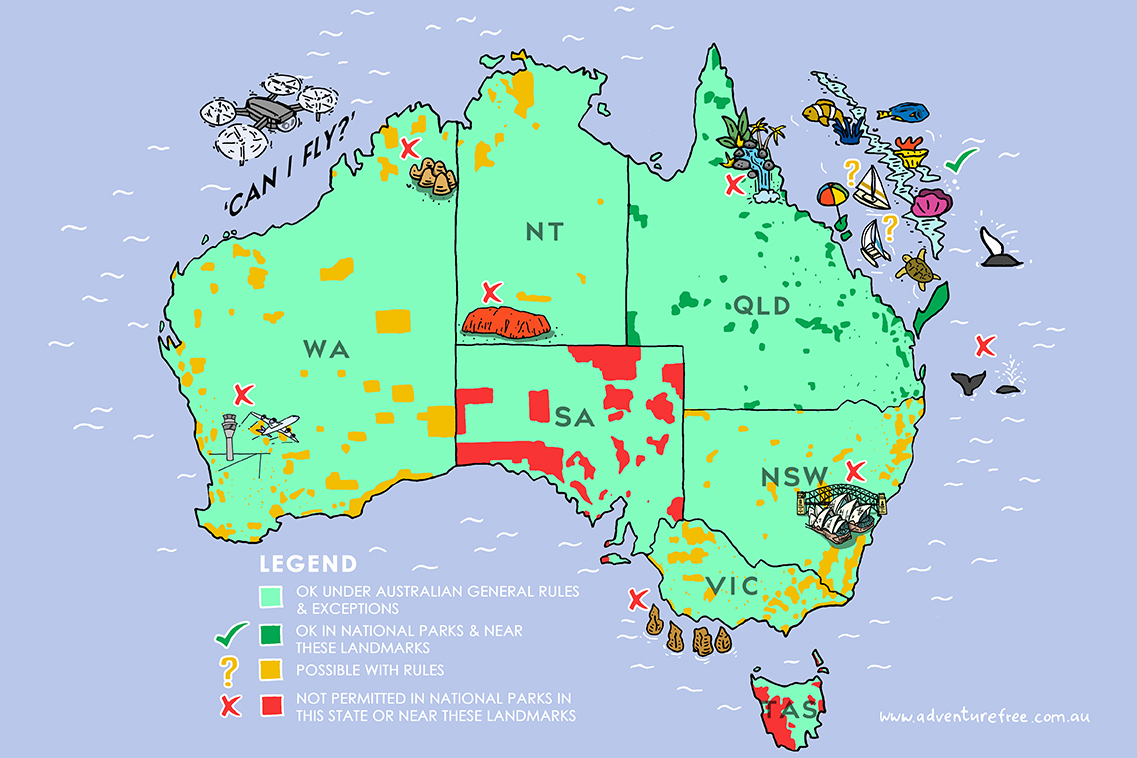Find, Compare & Book
Great Barrier Reef
Tours
(No Booking or Credit Card Fees!)
Can I Fly my Drone in Australia? | The Easy Guide
Nov 04, 2020
04/11/2020 By Ben Southall, Winner of the ‘Best Job in the World’ and AdventureFree Brand Ambassador

Other Drone Articles
- Part 1. Can I fly my drone in Australia?
- Part 2. Can I fly my drone over Australia’s famous landmarks?
- Part 3. Can I fly my drone over Australia’s National Parks?
- Part 4. The Conclusion: Which Tours can I take my Drone on?
Australia Wide Base Rules
With consumer drones becoming a realistic photographic and filmmaking tool for the everyday traveller taking one on holiday with you can seem like a great idea but with so many different rules and regulations imposed by the different states of Australia it’s not as easy as simply sending your new-fangled flying machine up in the air to soar with the boobies (they’re the blue-footed birds found around the coastline).
In this post we’ve brought together all information you’ll need to find out exactly where, when and how you can take to the skies and capture the beauty of Australia from the up high. Here’s our guide to staying on the right side of the law in the Great Southern Land:
What are the Rules?
There are 2 main tiers of rules:
1. Australia Wide Rules: There are a set of nationwide rules laid out by CASA (Civil Aviation Safety Authority) – the government organisation who take the fun out of….sorry, police the skies above Australia, so keeping them happy is your number one priority.
2. National Parks: are governed by the state authorities that are responsible for preservation and shared enjoyment of these spaces. The rules are all different and changing regularly. ALL pilots must adhere to the Base Rules, and if you want to make money from your drone, this is considered a ‘commercial’ use and there are a couple of extra requirements.
Base Rules:
- Your aircraft must be less than 2kg,
- Keep your aircraft in visual line-of-sight i.e. not too far away and not behind buildings etc where you can’t see it,
- Only fly in daylight hours,
- Don’t fly in clouds or foggy conditions,
- Not closer than 30 metres to vehicles, boats, people or buildings,
- Not over beaches, parks or sports pitches when there are helicopters in use,
- Not higher than 120 metres, if you do want to fly over 120 m you need to apply directly to CASA and the process will cost you around $120 per hour, with a minimum 3 hours charge.
- Not within 5.5km of airfields, aerodromes & helipads.
Other ‘Don’t Fly’ Situations
- Don’t fly anywhere within 300 metres of whales or dolphins (500 m if you’re in Queensland waters and it’s the famous white whale – Migaloo). And because you cant fly higher than 120 m, you cant fly above whales at all! without a high flight permit. It’s not worth the fine you’ll cop if they find your footage online!
- Over any emergency vehicles at the scene of an incident, bushfires (think about the fanning effect caused by a drone’s downdraft)
- Anywhere within 5.5km of any airport, aerodrome or helipad. Download the Safe to Fly? app from the team at Wickedcopters to find out if you’re in a restricted zone.
- Don’t fly over city centres which have generally no-fly-zones enforced around them anyway. If you’re thinking about filming anywhere with lots of people i.e. a festival, at the beach, over a sports event – then think again. Although the likelihood of a malfunction being very unlikely, if anything does go wrong and your drone smashes into a group of people, not only will you have to foot the bill for a new machine, but probably a few facial reconstructions at the same time. Stay away from crowds.
Commercial Users
Some extra rules If you receive any commercial benefit from your drone usage, then you cross the line and become a ‘commercial operator’.
Commercial uses include:when you upload your footage or images to YouTube, – websites or – social media channels – any other online video platform, This opens an entirely new can-of-worms, especially for overseas visitors.
Extra rules are:
- You need to register with CASA for an ARN (Aircraft Reference Number) is compulsory, takes up to five working days to process and requires an Australian home address to register.
- Submit a Flight Plan – Give CASA five days notice of the state and region you’re hoping to fly in. Perfect for residents, not so great if you’re here on holiday.
If you’ve just arrived on a plane for a short holiday then what do you do? Fly as a recreational user, don’t try and make any money out of the footage and you can take-off within minutes of landing on Australian soil…assuming you’re at least 5.5km from an airport of course.
Media
If you are a travel or drone blogger and are interested in collaborating with us – get in contact here.
*Drone rules are evolving, and we will update from time to time. This article is for information purposes only and please satisfy yourself of the rules before you fly. This article may not be relied upon as approval to fly.
Share the above map on your site





